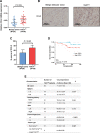Absolute monocyte count has a diagnostic role in distinguishing tumor marker-negative TGCT from benign testicular tumor via CCL2 regulation
- PMID: 37352031
- PMCID: PMC10289632
- DOI: 10.1097/MD.0000000000034114
Absolute monocyte count has a diagnostic role in distinguishing tumor marker-negative TGCT from benign testicular tumor via CCL2 regulation
Abstract
Clinically, for testicular tumor patients with negative tumor markers, how to distinguish the malignant from the benign is a difficult problem. This study aimed to assess the clinical significance of the absolute monocyte count (AMC) in differential diagnosis of testicular germ cell tumor with stage S0 (TGCTS0) and benign testicular tumor. In this retrospective single-center study, a total of 90 patients newly diagnosed with benign testicular tumor or TGCTS0 were reviewed. All patients received surgical intervention as the primary treatment method. AMC and other clinicopathological parameters were analyzed. Receiver operating characteristic (ROC) curves were constructed to assess the diagnostic power of investigated parameters, and to determine the optimal cutoff values. Kaplan-Meier curve analysis was used to study the survival of patients with TGCTS0. qRT-PCR and immunohistochemistry (IHC) were performed to examine the expression of C-C motif chemokine ligand 2 (CCL2) mRNA and protein respectively. Differential gene expression and functional enrichment analysis were performed using Gene Expression Omnibus and the Cancer Genome Atlas databases. The mean preoperative AMC in patients with TGCTS0 was significantly higher than that in patients with benign testicular tumor (P = .020). AMC > 0.485*10^9/L was identified to be associated with the presence of TGCTS0 (hazard ratio [HR] = 3.074, P = .026), and patients with higher AMC level had worse progression free survival (PFS) (P = .047). Furthermore, AMC combined with lactate dehydrogenase (LDH) achieved a better diagnostic efficacy for TGCTS0 (area under curve [AUC] = 0.695). Tumor-associated macrophages (TAMs) signature gene CCL2 was highly expressed in TGCT compared with normal testicular tissue. Functional enrichment analysis showed that CCL2 is closely involved in the Extracellular Matrix Organization pathway and positively correlated with the expression of various matrix metalloproteinases (MMPs). Elevated AMC may serve as a predictor of higher risk of TGCTS0, and CCL2 mediated TAMs infiltration and MMPs secretion is essential for the tumorigenesis of TGCT.
Copyright © 2023 the Author(s). Published by Wolters Kluwer Health, Inc.
Conflict of interest statement
The authors have no conflicts of interest to disclose.
Figures





References
-
- Sung H, Ferlay J, Siegel RL, et al. . Global cancer statistics 2020: GLOBOCAN Estimates of incidence and mortality worldwide for 36 cancers in 185 countries. CA Cancer J Clin. 2021;71:209–49. - PubMed
-
- Coursey Moreno C, Small W, Camacho J, et al. . Testicular tumors: what radiologists need to know--differential diagnosis, staging, and management. Radiographics. 2015;35:400–15. - PubMed
-
- Moch H, Cubilla A, Humphrey P, et al. . The 2016 WHO classification of tumours of the urinary system and male genital organs-part a: renal, penile, and testicular tumours. Eur Urol. 2016;70:93–105. - PubMed
-
- Shilo Y, Zisman A, Lindner A, et al. . The predominance of benign histology in small testicular masses. Urol Oncol. 2012;30:719–22. - PubMed
MeSH terms
Substances
Supplementary concepts
LinkOut - more resources
Full Text Sources
Medical

